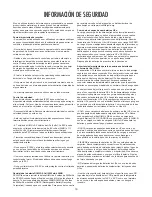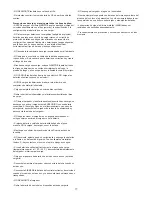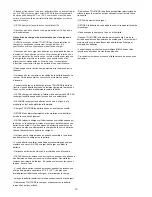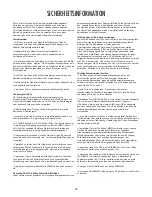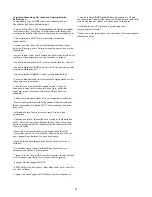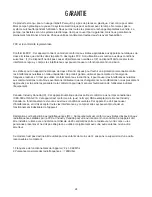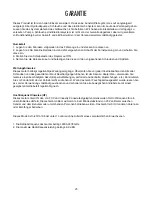
14
recycling center near you, ask your local hobby dealer or visit
www.call2recycle.org
Your model is able to use LiPo batteries.
Charging and discharging batteries has the potential for fire,
explosion, serious injury, and property damage if not performed per
the instructions. Before use, read and follow all manufacturer's
instructions, warnings, and precautions. In addition, Lithium Polymer
(LiPo) batteries pose a SEVERE risk of fire if not properly handled per
the instructions and require special care and handling procedures for
long life and safe operation. LiPo batteries are intended only for
advanced users that are educated on the risks associated with LiPo
battery use. RC4WD does not recommend that anyone under the age
of 14 use or handle LiPo battery packs without the supervision of a
knowledgeable and responsible adult. Dispose of used batteries
according to the instructions.
Important Warnings for users of Lithium Polymer (LiPo)
batteries:
• LiPo batteries have a minimum safe discharge voltage threshold that
should not be exceeded. The electronic speed control is equipped
with built-in Low-Voltage Detection that stops the vehicle when LiPo
batteries have reached their minimum voltage (discharge) threshold. It
is the driver's responsibility to stop immediately to prevent the battery
pack from being discharged below its safe minimum threshold.
• Low-Voltage Detection is just one part of a comprehensive plan for
safe LiPo battery use. It is critical to follow all instructions for safe and
proper charging, use, and storage of LiPo batteries. Make sure you
understand how to use your LiPo batteries. If you have questions
about LiPo battery usage, please consult with your local hobby dealer
or contact the battery manufacturer. As a reminder, all batteries
should be recycled at the end of their useful life.
• ONLY use a Lithium Polymer (LiPo) balance charger with a balance
adapter port to charge LiPo batteries. Never use NiMH or NiCad type
chargers or charge modes to charge LiPo batteries. DO NOT charge
with a NiMH-only charger. The use of a NiMH or NiCad charger or
charge mode will damage the batteries and may cause fire and
personal injury.
• NEVER charge LiPo battery packs in series or parallel. Charging
packs in series or parallel may result in improper charger cell
recognition and an improper charging rate that may lead to
overcharging, cell imbalance, cell damage, and fire.
• ALWAYS inspect your LiPo batteries carefully before charging. Look
for any loose leads or connectors, damaged wire insulation, damaged
cell packaging, impact damage, fluid leaks, swelling (a sign of internal
damage), cell deformity, missing labels, or any other damage or
irregularity. If any of these conditions are observed, do not charge or
use the battery pack. Follow the disposal instructions included with
your battery to properly and safely dispose of the battery.
• DO NOT store or charge LiPo batteries with or around other
batteries or battery packs of any type, including other LiPos.
• Store and transport your battery pack(s) in a cool dry place. DO
NOT store in direct sunlight. DO NOT allow the storage temperature
to exceed 140°F or 60°C, such as in the trunk of a car, or the cells
may be damaged and create a fire risk.
• DO NOT disassemble LiPo batteries or cells.
• DO NOT attempt to build your own LiPo battery pack from loose
cells.
Failure to operate your model in a safe and responsible manner may
result in property damage and serious injury. The precautions outlined
in this manual should be strictly followed to help ensure safe
operation. You alone must see that the instructions are followed and
the precautions are adhered to.
Important Points to Remember
• Your model is not intended for use on public roads or congested
areas where its operation can conflict with or disrupt pedestrian or
vehicular traffic.
• Never, under any circumstances, operate the model in crowds of
people. Your model could cause injury if allowed to collide with
anyone.
• Because your model is controlled by radio, it is subject to radio
interference from many sources that are beyond your control. Since
radio interference can cause momentary loss of radio control, always
allow a safety margin in all directions around the model in order to
prevent collisions.
• The motor, battery, and speed control can become hot during use.
Be careful to avoid getting burned.
• Don’t operate your model at night, or anytime your line of sight to the
model may be obstructed or impaired in any way.
• Most importantly, use good common sense at all times.
Speed Control
Your model’s electronic speed control (ESC) is an extremely powerful
electronic device capable of delivering high current. Please closely
follow these precautions to prevent damage to the speed control or
other components.
• Disconnect the Battery: Always disconnect the battery from the
speed control when not in use.
• Insulate the Wires: Always insulate exposed wiring with heat shrink
tubing to prevent short circuits.
• 6-7 NiMH cells or 2-3 LiPo cells (2s/3s): The ESC can accept a
maximum input voltage of 8.4 volts (NiMH) or 11.1 volts (3s LiPo).
Always adhere to the minimum and maximum limitations of the ESC
as stated in the specifications table.
• Transmitter on First: Switch on your transmitter first before switching
on the speed control to prevent runaways and erratic performance.
• Don't Get Burned: The ESC and motor can become extremely hot
during use, so be careful not to touch them until they cool. Supply
adequate airflow for cooling.
• Use the Factory-Installed Connectors: Do not change the battery
and motor connectors. Improper wiring can cause fire or damage to
the ESC.
• No Reverse Voltage: The ESC is not protected against reverse
polarity voltage.
Recycling RC4WD 6-Cell 3000mAh NIMH Battery Pack
RC4WD strongly encourages you to recycle RC4WD 6-Cell 3000mAh
NIMH Battery Pack batteries when they reach the end of their useful
life. Do not throw batteries in the trash. All RC4WD 6-Cell 3000mAh
NIMH Battery Packs display the RBRC (Rechargeable Battery
Recycling Corporation) icon, indicating they are recyclable. To find a
SAFETY INFORMATION

















